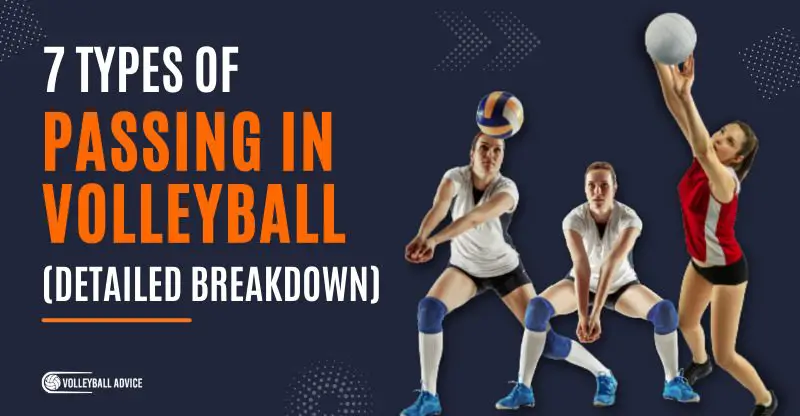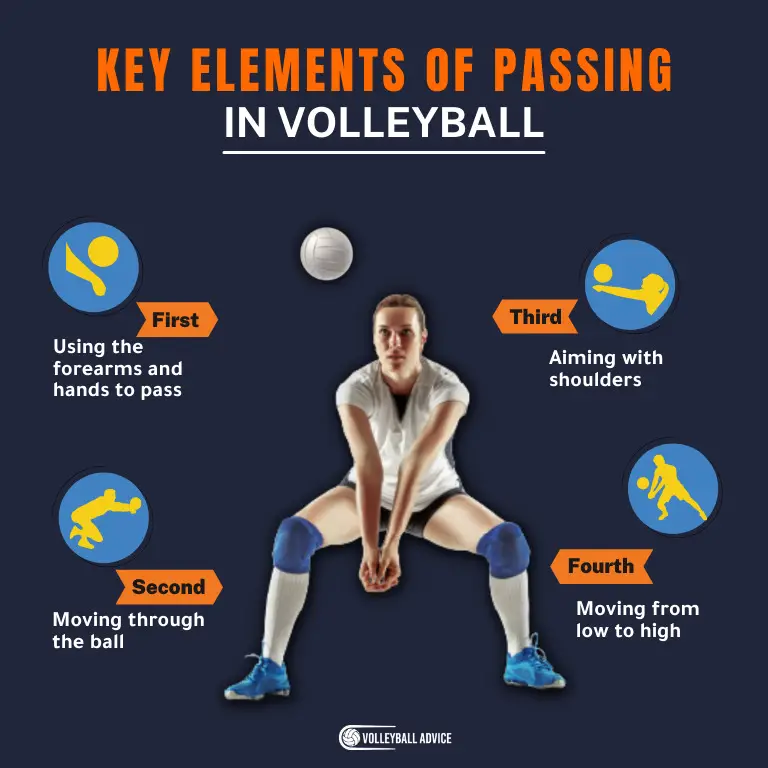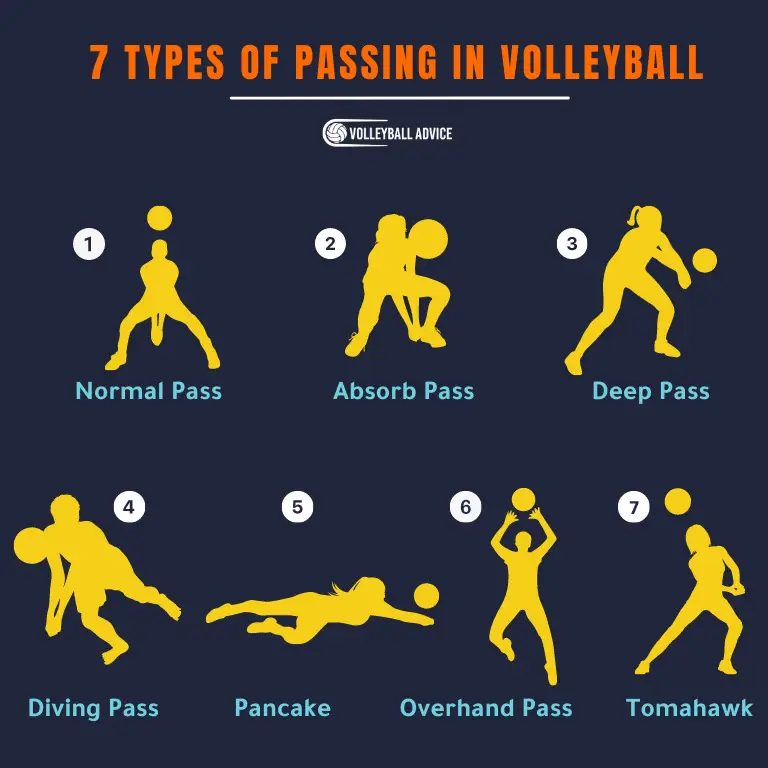7 Types of Passing in Volleyball (Detailed Breakdown)
Everything begins with the pass. Without a good pass, there can be no set, no hit, and no chance of scoring.
Since this is true, understanding the types of passing in volleyball is incredibly important to choosing the right one to perform and is the first step towards mastering this skill.
So, what are the different types of passing in volleyball? Volleyball has seven types of passing: the normal pass (or forearm pass), absorb pass, deep pass, diving pass, pancake, overhand pass, and the tomahawk. While some of these types have more specific uses than others, such as the tomahawk in beach volleyball, all are useful and should be incorporated into your skillset.
Most players when starting out will only be familiar with the “normal pass”, where you shrug your shoulders and clasp your forearms together, face your torso towards the target, and pop upwards and through while maintaining your arm platform.
While this will remain your bread and butter of passing throughout your volleyball career, this type of passing has its limitations. Being able to absorb a pass or “pancake” a ball will not only let you save the point for your team, but also give you the option to counterattack.
Today, I’m going to break down the seven different types of passing and discuss how and where to use them. By the end of this article, you should be able to:
- Identify different kinds of passing
- Know when to use each type
- Understand the movement required for each
What Is A Volleyball Pass?
Passing in volleyball is the action of bouncing the ball off of a platform you create in order to send it to a specific point on the court or a teammate, usually the setter.
While a pass can be executed using any part of the body, even the foot or elbow, it is most commonly executed with the hands, wrists, and forearms. This provides more control while also allowing the player to see where they are passing and “aim” with their shoulders.
The seven different types of passing look and act very differently, but there are several key elements that are generally attributed to each.
Key Elements of Passing
No matter which type of volleyball pass you do, they will all incorporate the following elements:
- Using the forearms and hands to pass
- Moving through the ball
- Aiming with shoulders
- Moving from low to high
Using The Forearms And Hands To Pass
First, a pass should be executed with the forearms and hands.
Some coaches run passing drills where the object is to keep the ball from touching the ground as long as possible without using the hands, and while this is a good drill to practice ball handling and reactions it isn’t a desirable habit to get into.
Moving Through The Ball
Second, you need to aim to move through the ball when passing.
Whether it’s setting, spiking, serving, or passing, every player should be continuing to move forward when contacting the ball. Moving forward prevents the ball from going straight up or behind you, causing further issues for your team and preventing an attacking spike. Move forward to maintain control.
Aiming With Shoulders
Third, you need to aim with your shoulders when passing.
Not many players think about this, but the angle of your shoulders determines the direction of your pass. Extend your arms in front of you and imagine you are holding a mirror: the ball will bounce the way that the mirror is angled depending how you raise or drop your shoulders. Practice passing with your shoulder form in mind and see the difference firsthand.
Moving From Low To High
Fourth, you need to move from high to low when passing.
The reason for this is twofold: to put the ball high enough for your team to be able to set up beneath it, and to train your body to pass with the legs as well as arms.
Using your whole body to move as one unified platform lessens the chance of shanking a pass and will keep your control on the straight and narrow.
Keep those feet moving and remember – move through the ball!
7 Passes: A Breakdown
Now begins a detailed breakdown of every type of passing in volleyball.
Some positions in volleyball are more passing-heavy than others; liberos (as the designated “defensive specialist” on the court) should always pass more than outside hitters, and middle blockers might never get to pass at all during the course of the match.
No matter the amount of passing that is expected of your position, or how often you actually pass during a game, a volleyball player should always be ready to pass. Stray balls bouncing off of blocks, tips to the front row, and shanked passes may all require you to pass, so be sure to incorporate these different types of passing into your next practice session.
I’ve seen my fair share of players standing idly by as the ball dropped to the floor, or even allowing themselves to get hit by a serve, expecting someone else to take the pass. These are avoidable mistakes that give away points for silly reasons.
Check out this guide: Hand Position For Volleyball Bumps, Passes, and Digs (6 Rules)
Be assertive, call the ball as yours, and put your practice to good use with one of these types of passing.
The seven types of passing in volleyball are:
- Normal pass
- Absorb pass
- Deep pass
- Diving pass
- Pancake
- Overhand pass
- Tomahawk
1. Normal Pass
A normal pass is a ball that is received by extending the arms in front of one’s self with the wrists locked together and the shoulders shrugged to create a stable platform.
Also known as “standard form” or “forearm passing”, this type of pass is by far the most common and is the first taught during the learning phase. During your volleyball career, this will account for around 70% of all passing done. It is both incredibly reliable and accurate with proper technique, and has earned the title of “normal pass” for good reason.
Aside from the arm position, this pass should be executed by rising through the ball upwards and forward using the legs. If necessary, swing your arms slightly to move the ball towards your target, but remember to maintain your platform throughout the process.
This pass is best used on any ball that is not hard-driven that you can reach before it drops below the height of your waist.
Some coaches claim that this is the only pass that should be necessary, and if all six players on the court use proper footwork to reach the ball in time that might be true. Stay on your toes and use a split step to keep your weight forward, moving quickly to put your body in the path of the ball. Plant your feet, angle your shoulders towards the target, and pass.
2. Absorb Pass
An absorb pass is a ball that is received almost identical to a normal pass, but involves absorbing the impact from the ball by bending your knees and leaning backward.
You always want to be moving through the ball, but sometimes a spike is hit hard enough that a normal pass isn’t enough to prevent it from going back over the net. In this situation, the emphasis on movement is changed to moving with the ball instead of through it, and is the only pass in which the rule of moving through the ball is broken.
Think of this pass as sinking into the floor, and sitting downwards slightly as you contact the ball. Open your body by lowering your arms and leaning backwards, angling towards the ceiling instead of your target, and redirect the ball’s momentum upwards instead of forwards.
The goal with this pass is not to land a pinpoint pass on top of your setter’s head, but to keep the ball in play. If the ball hasn’t touched the ground, it’s not over.
Use this pass to pick up the hardest hits and don’t be afraid to put yourself in the way of a spike. Be brave and trust in your platform.
3. Deep Pass
A deep pass is a ball that is received deep in the court and requires the use of an arm swing to return it to play rather than being received only by a passing platform.
While normal passes might incorporate slight arm swings, deep passes use large, sweeping movements to generate the power from unideal positions – usually mid-run and off balance. This can be used over the head to pass it behind a player but is more commonly used from the side where a little more accuracy can be obtained, reminiscent of a tennis forearm swing.
To perform a deep pass, maintain a solid arm platform without needing to maintain the shoulder shrug or body positioning, as usually this is impossible for the situation you will use it in. Attempt to get behind the ball as much as possible, and swing towards your target, remembering to drive with your legs and arms in unison as much as possible.
Deep passes are used when players are chasing down the ball far outside the boundaries of the court and simply need to pass it a long distance: either to their teammates or over the net.
It’s important to note that this kind of pass can put the player in a dangerous situation as it is usually performed from an off-balanced stance or mid-run. The maintained momentum will send you away from court and potentially remove you from the next few seconds of gameplay.
This is ok.
Even more than diving, this is the kind of passing which players generally get injured performing, as they attempt to save the ball before it hits a wall or bounces into the bleachers.
While sacrificing yourself for the ball is admirable – noble even – it doesn’t help your team, and it certainly doesn’t help you.
View this post on Instagram
Make sure to take care of yourself first and foremost and avoid any walls, people, or chairs that you are being propelled into. Be mindful of your ankles as you pivot and change direction, and take your time if needed to return to play. Chances are that the point will be over by the time you return to your position anyway.
4. Diving Pass
A diving pass is a ball that is received during a dive, where the player throws themselves through the air in a controlled fall in order to reach a difficult ball.
Diving is one of the coolest moves in volleyball, and some liberos have perfected techniques that let them turn their momentum into a roll, landing on their feet in a stunning display of gymnastic ability.
For the rest of us, diving looks like a controlled fall where we contact the ball in a pass almost parallel to the ground. It is incredibly useful for reaching difficult balls, and absolutely essential for any aspiring pro liberos.
A diving pass retained all the elements of the normal pass – including little-to-no arm swing – without being firmly planted on the ground. A good core is necessary to a proper pass, and the momentum of your dive combined with the momentum of the ball is what creates the height of the pass.
Start in a passing position and step towards the dropping ball that is below waist height (if it’s above this, move your feet! You can get it). Allow yourself to fall forward out of your stance and push forward to move as parallel to the ground as possible, ideally as close to the ground as you can get.
Contact the ball before you touch the ground, and land on your hips instead of your stomach while catching yourself with your hands. Done correctly, you should feel no pain and simply slide across the court.
Diving without understanding proper technique can be harmful to your body, so be sure to ask your coach or an experienced player to help when you’re first learning. Start small before committing to bigger dives, and soon you’ll be sliding across the court like a volleyball penguin pro.
5. Pancake
A pancake is a ball that is passed by bouncing off of a player’s hand that was placed on the ground beneath the ball.
Usually paired with a diving motion, pancakes are primarily used to pass balls that drop far beyond the normal reach of passing. A last-ditch effort to keep the ball from touching the floor, the only thing separating the two is a player’s hand that they place between them ‒ often, just in time.
To perform a pancake, practice first without diving. Drop the ball from any height and attempt to place your hand between the ball and the floor in order to pass it directly up.
Next, start by lying on the ground and crawling or sliding over to where the ball is dropping and pass the ball by using your pancake. Have a teammate drop it from waist height at the ten foot line while you start at the baseline to get the feeling of urgency associated with its use.
Continue to up the difficulty by adding different levels of diving, and soon you’ll have not only a very useful passing tool at your disposal, but the most delicious breakfast food (and meme) in the volleyball world.
6. Overhand Pass
An overhand pass is a ball that is passed above the chest area in setting position.
Overhand passes, or “volleys”, use the same motion and technique as setting and are an extremely controlled way to pass a volleyball.
This type of passing is best used when receiving float serves to reduce the disorientation generated by their drift, and any time a ball is higher than your chest.
Many normal passes can be turned into overhand passes by taking a step forward – raising the point at which you contact the ball – and the opposite is true as many overhand passes can be turned into a normal pass by stepping backwards. If you find yourself struggling with one, use your footwork to perform the pass you want.
7. Tomahawk
A tomahawk is a ball that is passed above the head with the hands clasped together as if holding a tomahawk (a “throwing ax”).
This final type of passing is often used as a split-second reaction to a ball flying at your face but is used widely in beach volleyball as an alternative to setting.
To perform a tomahawk, clasp your hands together above your head, out of the normal passing platform, and contact the ball with the bottom of your hands. This will bump the ball upwards to your team and can be angled for different heights, directions, and power.
Although it is rarely used in indoor volleyball, it is a worthwhile skill that is worth practicing that will improve your ball handling and comfort with passing the ball from imperfect angles or with different parts of your body. Be careful not to think of this as a replacement for overhand passing or setting, but as a useful tool to give you an edge.
Final Thoughts
I challenge you to choose two of three of the passes we listed here and focus on them during your next practice. How does your body move differently? How much control did you have? How many pancakes could you get in one practice?
Other Resources
- 16 Types Of Spiking In Volleyball (Helpful Visuals)
- 10 Types Of Serves In Volleyball (Detailed Breakdown)
- Types of Sets In Volleyball: 18 Types Explained
- Volleyball Positions, Roles, & Formations (Complete Guide)
- How To Play Volleyball Without Hurting Your Arms (11 Tips)
About The Author
Ailan Samuel is a writer and athlete who has played volleyball at the university, club, and national level since 2012. He has competed successfully in both beach and indoor competitions, resulting in four silver and two gold medals, and was awarded the Half-Blue while playing in Scotland. He received his MA in English and Medieval History from the University of St Andrews, Scotland, and is currently studying for his MA in Publishing and Creative Writing at Bournemouth University.



